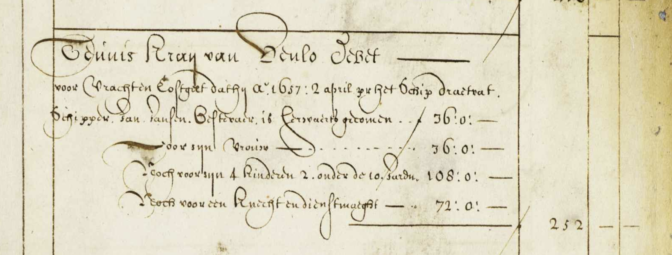If you are lucky, an English translation exists for Dutch records. For example, many New Netherland records have been translated.
In some cases though, what is presented as translations are actually abstracts. The original may have more information. Another aspect to consider is that translations are interpretations, and may have mistakes.
For example, an account book of the West India Company 1650-1664 that includes money paid for passage to New Netherland is often presented in translations as a “passenger list.” Some translations omit the financial details, omit the ages of the children, or omit the notes that are added to the original.
Using translations may be necessary if you do not speak the language. Even if you don’t speak the language, it is worthwhile to check the original. In the case of the account books, that would have told you there were financial details there, and you could have seen that the original has far more lines than the translation. That would be a sign to get help from someone who speaks the language.
Example: Teunis Kraij

This record for Teunis Kraij has the following information:
Teunis Kraij from Venlo, debit for freight, victuals when he came here on 2 April 1657 on the ship Draetvat skipper Jan Jansen Bestevaer - fl. 36:0:- For his wife fl. 36:0:- Also for his four children 2 under 10 years old 108:0:0 For a hired hand and servant maid fl. 72:0:0 ------------- fl. 2521
The publication “Passengers to New Netherland” presents itself as a translation. It has the following information:
Teunis Kray, from Venlo, wife and four children (two of whom under ten years of age), and two servants.2
The information about the ship, its captain and date is moved to a heading that groups several entries. The grouping does not appear in the original, and not all people have been put under the correct voyage though Teunis Kray was.
The original entry has a bit more background information and shows that he had a male and female servant. It shows they paid the passage themselves, rather than the company paying for their passage as they did for some tradesmen and farmers. It shows that the full price was paid for the servants, indicating they were adults (or at least, above ten years old).
The introduction of the yearbook where this is published even says “for these reasons it seems to me that the list in its present form, even with the corrections, is very unsatisfactory.” However, the amount of work to transform the list of names into a true translation was considered to be too much. This “translation” has been reproduced in many places though, often without the introduction that explains its shortcomings. Many people have used this translation without realizing its problems.
- West India Company, list of emigrants from Holland to New Netherland from 1654 to 1664, with their accounts, debit and credit, fol. 3, Teunis Kraij voyage (2 April 1657); vol. 14, Dutch colonial administrative correspondence, 1646-1664, series A1810, New York State Archives, Albany, New York; consulted as digital images, New York State Archives (http://digitalcollections.archives.nysed.gov/ : accessed 4 October 2019), identifier: NYSA_A1810-78_V14_0083.
- “Passengers to New Netherland,” Holland Society Yearbook (1902), 5; imaged at Internet Archive (https://archive.org/details/yearbookofhollan1902holl/page/4/mode/2up : accessed 6 December 2021).

